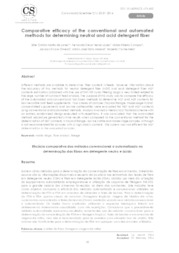Comparative efficacy of the conventional and automated methods for determining neutral and acid detergent fiber.
Comparative efficacy of the conventional and automated methods for determining neutral and acid detergent fiber.
Author(s): LANES, E. C. M. de; LOPES, F. C. F.; CAMPOS, N. R.; OLIVEIRA, J. S. e; MORENZ, M. J. F.; FRISCHE-NETO, R.
Summary: Different methods are available to determine fiber content in feeds. However, information about the accuracy of this methods for neutral detergent fiber (NDF) and acid detergent fiber ADF contents estimation (obtained with the use of TNT-100 nylon filtering bags) is very limited related to the large number of ruminant feed analysis. The purpose of this study was to compare the efficacy of the automated and conventional Van Soest methods to determine NDF and ADF contents for bovine cattle and feed supplements. Four classes of samples (tropical forage, maize silage hybrid, concentrated supplements and bovine cattlecattle) were evaluated for NDF and ADF contents using conventional and automated methods. Analysis involved a hierarchical factorial scheme with an entirely randomized design executed with repetitions. It was concluded that the automated method procedure generated similar results when compared to the conventional method for the determination of NDF contents in tropical forage, bovine cattle and maize silage samples, although is not recommended for samples with a high starch content. This system was not efficient for ADF determination in the evaluated samples.
Publication year: 2016
Types of publication: Journal article
Unit: Embrapa Dairy Cattle
Keywords: Fiber analysis, Maize silage, forage
Observation
Some of Embrapa's publications are published as ePub files. To read them, use or download one of the following free software options to your computer or mobile device. Android: Google Play Books; IOS: iBooks; Windows and Linux: Calibre.
Access other publications
Access the Agricultural Research Database (BDPA) to consult Embrapa's full library collection and records.
Visit Embrapa Bookstore to purchase books and other publications sold by Embrapa.

